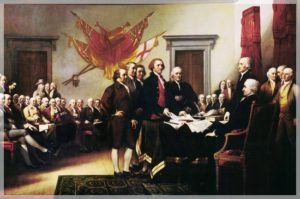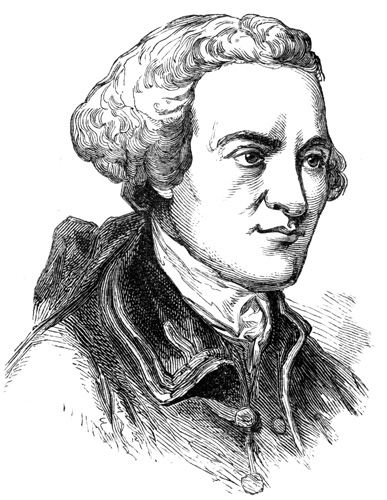 The 56 Signers
The 56 Signers
The Declaration was transposed on paper, adopted by the Continental Congress, and signed by John Hancock, President of the Congress, on July 4, 1776
Hancock was a smuggler who grew rich. Twenty-four of the signers were lawyers and jurists. Eleven were merchants, nine were farmers and large plantation owners, men of means, well educated, one was a scientist and publisher.
Many owned slaves. Some of the signers did free their slaves after proclaiming that all men are created equal, but most others—like Thomas Jefferson—kept their slaves indefinitely.
The majority of the signers were nominal Christians of different denominations including Quakers, Unitarians, Calvinists, Catholics, Dutch Reform Church, and Episcopalians. Whatever the name of their faiths, the leading figures, including Jefferson Adams, Franklin, were adamantly against any organized religion and were at most followers of Deism, a vague idea that there is some power behind creation. Thomas Paine was probably an atheist but the author of Common Sense he did not sign the Declaration

John Hancock became wealthy as a smuggler. John Hancock had a regular practice. When his ships arrived in Boston Harbor, John would invite the port duty officer to his office for a refreshment, or a drink. The goods would be unloaded from the ship and disappear into the city, without paying the tax to be imposed. On one occasion, the British authorities confiscated John Hancock’s favorite ship, the Liberty. John Hancock hired his close friend and fellow Harvard College alum, John Adams, an attorney, to defend him. John Adams, through shrewd legal motions and arguments, convinced the Judge in Admiralty to listen to his grievance, and the judge decided to postpone the case. The Judge never reconvened the case. John Hancock didn’t have to pay the fine that was threatened to be imposed. The fine which was to be attached would have taken most of John Hancock’s vast estate.
And the fates of the signers?
- Five signers were captured by the British as traitors, and tortured before they died.
- Twelve had their homes ransacked and burned.
- Two lost their sons serving in the Revolutionary Army;
- Two others had their sons captured.
- Nine of the 56 fought and died from wounds or hardships of the Revolutionary War.
- Carter Braxton of Virginia, a wealthy planter and trader, saw his ships swept from the seas by the
British Navy. He sold his home and properties to pay his debts, and died in rags. - Thomas McKeam was so hounded by the British, when his ships arrived in Boston Harbor,
he was forced to move his family almost constantly. He served in the Congress without pay, and his family
was kept in hiding. His possessions were taken from him, and poverty was his reward. - Tory vandals or soldiers looted the properties of Dillery, Hall, Clymer, Walton, Gwinnett, Heyward, Rutledge, and Middleton.
- At the battle of Yorktown, Thomas Nelson, Jr., noted that the British General Cornwallis had taken over the Nelson home for his headquarters. He quietly urged General George Washington to open fire. The home was destroyed, and Nelson died bankrupt.
- Francis Lewis had his home and properties destroyed. The enemy jailed his wife, and she died within a few months.
- John Hart was driven from his wife’s bedside as she was dying. Their 13 children fled for their lives. His fields and his gristmill were laid to waste. For more than a year he lived in forests and caves, returning home to find his wife dead and his children vanished.